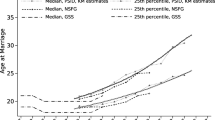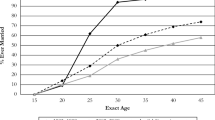Abstract
This article examines competing theoretical claims regarding how an individual’s education will affect his or her likelihood of interracial marriage. I demonstrate that prior models of interracial marriage have failed to adequately distinguish the joint and marginal effects of education on interracial marriage and present a model capable of distinguishing these effects. I test this model on black-white interracial marriages using 1980, 1990, and 2000 U.S. census data. The results reveal partial support for status exchange theory within black male-white female unions and strong isolation of lower-class blacks from the interracial marriage market. Structural assimilation theory is not supported because the educational attainment of whites is not related in any consistent fashion to the likelihood of interracial marriage. The strong isolation of lower-class blacks from the interracial marriage market has gone unnoticed in prior research because of the failure of prior methods to distinguish joint and marginal effects.
Similar content being viewed by others
References
Alba, R.D., J.R. Logan, and B.J. Stults. 2000. “How Segregated Are Middle-Class African Americans?” Social Problems 47:543–58.
Bernard, J. 1966. “Note on Educational Homogamy in Negro-White and White-Negro Marriages, 1960.” Journal of Marriage and the Family 28:274–76.
Clogg, C.C. and S.R. Eliason. 1987. “Some Common Problems in Log-Linear Analysis.” Sociological Methods and Research 16:8–44.
Condran, J.G. 1979. “Changes in White Attitudes Toward Blacks: 1963–1977.” The Public Opinion Quarterly 43:463–76.
Davis, K. 1941. “Intermarriage in Caste Societies.” American Anthropologist 43:376–95.
Demo, D.H. and M. Hughes. 1990. “Socialization and Racial Identity Among Black Americans.” Social Psychology Quarterly 53:364–74.
Du Bois, W.E.B. 1899. The Philadelphia Negro. No. 14 in Series in Political Economy and Public Law. Philadelphia: University of Pennsylvania.
Fu, V.K. 2001. “Racial Intermarriage Pairings.” Demography 38:147–59.
Gordon, M.M. 1964. Assimilation in American Life. New York: Oxford University Press.
Greeley, A.M. and P.B. Sheatsley. 1971. “Attitudes Toward Racial Integration.” Scientific American 225:13–19.
Heer, D.M. 1974. “The Prevalence of Black-White Marriage in the United States, 1960 and 1970.” Journal of Marriage and the Family 36:246–48.
Hwang, S.-S., R. Saenz, and B.E. Aguirre. 1995. “The SES Selectivity of Interracially Married Asians.” International Migration Review 29:469–91.
Hyman, H.H. and P.B. Sheatsley. 1964. “Attitudes Toward Desegregation.” Scientific American 211:16–23.
Hyman, H.H. and C.R. Wright. 1979. Education’s Lasting Influence on Values. Chicago: University of Chicago Press.
IPUMS. 2003. IPUMS User’s Guide. Minneapolis, MN: Minnesota Population Center. Available online at http://www.ipums.org/usa/doc.html
Jackman, M.R. and M.J. Muha. 1984. “Education and Intergroup Attitudes: Moral Enlightenment, Superficial Democratic Commitment or Ideological Refinement?” American Sociological Review 49:751–69.
Kalmijn, M. 1993. “Trends in Black/White Intermarriage.” Social Forces 72:119–46.
— 1998. “Intermarriage and Homogamy: Causes, Patterns, Trends.” Annual Review of Sociology 24:395–421.
Lieberson, S. and M.C. Waters. 1988. From Many Strands: Ethnic and Racial Groups in Contemporary America. New York: Russell Sage Foundation.
Mare, R.D. 1991. “Five Decades of Educational Assortative Mating.” American Sociological Review 56:15–32.
Massey, D.S. and N.A. Denton. 1993. American Apartheid: Segregation and the Making of the Underclass. Cambridge, MA: Harvard University Press.
Massey, D.S. and M.J. Fischer. 1999. “Does Rising Income Bring Integration? New Results for Blacks, Hispanics, and Asians in 1990.” Social Science Research 28:316–26.
Merton, R.K. 1941. “Intermarriage and the Social Structure: Fact and Theory.” Psychiatry 4: 361–74.
Monahan, T.P. 1976. “An Overview of Statistics on Interracial Marriage in the United States, With Data on Its Extent From 1963–1970.” Journal of Marriage and the Family 38:223–31.
Porterfield, E. 1978. Black and White Mixed Marriages. Chicago: Nelson-Hall.
Qian, Z. 1997. “Breaking the Racial Barriers: Variations in Interracial Marriage Between 1980 and 1990.” Demography 34:263–76.
Quinley, H.E. and C.Y. Glock. 1979. Anti-Semitism in America. New York: Free Press.
Raftery, A.E. 1995. “Bayesian Model Selection in Social Research.” Pp. 111–63 in Sociological Methodology, edited by P. Marsden. Washington, DC: American Sociological Association.
— 1996. “Approximate Bayes Factors and Accounting for Model Uncertainty in Generalised Linear Models.” Biometrika 83:251–66.
Rosenfeld, M.J. 2005. “A Critique of Exchange Theory in Mate Selection.” American Journal of Sociology 110:1284–325.
Ruggles, S. and M. Sobek. 1997. Integrated Public Use Microdata Series: Version 2.0. Minneapolis, MN: Historical Census Projects, University of Minnesota.
Schuman, H., C. Steeh, L. Bobo, and M. Krysan. 1997. Racial Attitudes in America: Trends and Interpretations, rev. ed. Cambridge, MA: Harvard University Press.
Schwartz, C.R. and R.D. Mare. 2005. “Trends in Educational Assortative Marriage From 1940 to 2003.” Demography 42:621–46.
Selznick, G.J. and S. Steinberg. 1969. The Tenacity of Prejudice. New York: Harper and Row.
Sung, B.L. 1990. “Chinese American Intermarriage.” Journal of Comparative Family Studies 21:337–52.
Taylor, G.D., P.B. Sheatsley, and A.M. Greeley. 1978. “Attitudes Toward Racial Integration.” Scientific American 238:42–49.
Wilson, W.J. 1978. The Declining Significance of Race: Blacks and Changing American Institutions. Chicago: University of Chicago Press.
— 1987. The Truly Disadvantaged: The Inner City, the Underclass, and Public Policy. Chicago: University of Chicago Press.
Wong, M.G. 1989. “A Look at Intermarriage Among the Chinese in 1980.” Sociological Perspectives 32:87–107.
Author information
Authors and Affiliations
Additional information
I thank Michael Hout and Tom DiPrete for their helpful comments.
Rights and permissions
About this article
Cite this article
Gullickson, A. Education and black-white interracial marriage. Demography 43, 673–689 (2006). https://doi.org/10.1353/dem.2006.0033
Issue Date:
DOI: https://doi.org/10.1353/dem.2006.0033




